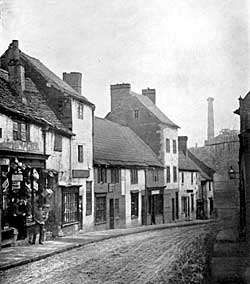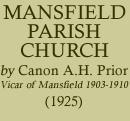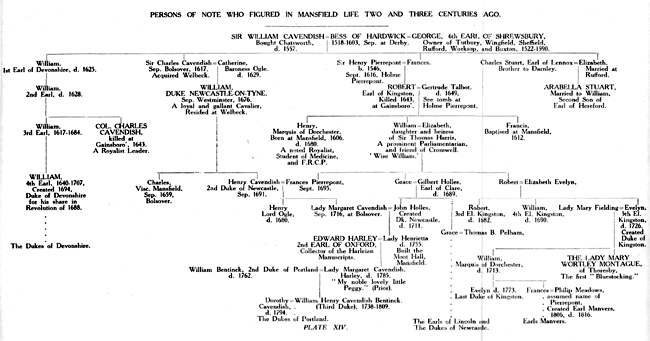< Previous | Contents | Next >
THE INTAKE (See p. 45).
A copy of depositions taken in Mansfield in 1699, has lately come under notice, and confirms us in the opinion that the adjustment of the Intake Estate, arrived at in 1884, by which the Grammar School, S. Mark's, and the Hospital were each to receive one-third, alienated the estate from its original purpose. We can scarcely think the Commissioner who adjudicated then can ever have seen these depositions, for it is tolerably clear to an unprejudiced mind that the Intake originally was acquired for the benefit of the Concionator, or afternoon preacher, at the Parish Church.
In 1699 one John Gurnon, who was born in 1634, deposed that Mr. Firth, who felt the School had too little belonging to it, in 1656 prevailed upon the sole trustee of the Intake, Mr. Rowland Dand, to devote one-third of the proceeds of the Intake to the School, reserving two-thirds for the Vicar. This was the first time the School received a share. One Thos. Wheat deposed that before the arrangement of 1656 was arrived at, the Intake was always reputed to be the property of the Vicar. One Richard Burbidge deposed that Mr. Dand showed great reluctance to alienate one-third from the Church, but was induced by the Vicar, Mr. Firth, to do so. One Mr. Hugh Baskerville, who was born in 1620, asserted that Mr. Dand was much distressed at the agreement of 1656, thinking he had been guilty of sacrilege.
We murmur not at the agreement arrived at in 1884, but had these depositions of 1699 been forthcoming then, we scarcely think there would have been found those to argue, the Church had no claim to even a share of the Intake Estate.
THE PARISH CLERK'S BOOK (See p. 24).
In the parish clerk's book belonging to S. Peter's is a page with a list of burial fees. There are two sets, one for burials in the Church and the other for burials in the Churchyard. The list of burial fees for a Church interment concludes with this interesting item: "fore inviteing 1s. 0d." We here have a reminder of an ancient custom which died out long ago, viz., the giving of doles at a funeral. Sometimes the dole took the form of pence and half-pence, and at others little rolls of bread, the distributions of which were made to the poor, who frequently flocked in great numbers to the house of the dead before the corpse was brought out. Sometimes the clerk went round the parish with the loaves, leaving one at every house, without discriminating between the rich and poor, and not to receive one was a mark of singular disrespect. Often the amount to be given in doles was specified in the Will, and bequests of bread are survivals of the custom, tending to keep the memory of the deceased in the minds of the inhabitants.
This book also shows that Firth was so puritanically minded that he allowed Francis Watson, who was elected "Parish Register " in 1653, to continue in office until 1678, twelve years longer than he had any right to do.
It is from this book, too, we discover the date of birth, February 13th, 1703, of Robert Dodsley, the celebrated bookseller, who suggested to Johnson that he should write a dictionary, and who also published his works.
THE INCISED SLAB IN THE EAST WALL OF THE VESTRY.
The Rev. Charles Kerry, in the XVI. vol. of his MSS., p. 368 (Derby Free Library) suggests that this stone commemorates the Architect or Master Mason of the Church when it was enlarged, 1420. The tracery on the stone and in the windows is identical.
The stripping of the walls of the interior of the Church of plaster in 1907, and the laying bare the original stone-work, was a delicate operation, but enormously improved the appearance of the Church. Unfortunately it entailed the removal of some of the brasses and memorials to other positions than they had originally occupied.

PLATE XIII. Kirkgate. Shops built on the Garden attached to the Mansion belonging to the Southwell Chantrey Priests and for four Centuries leased by the Vicar and Churchwardens of Mansfield.
This pamphlet is not intended for the severe criticism of antiquarians. Facts brought to light by future discoveries will, too, possibly reveal many inaccuracies. Two years is a time insufficient to become acquainted with the secrets of such a Church as ours. There is still much to be discovered, much to be learnt. But should this most imperfect sketch of the history and fabric of the Church, excite in any a warmer love for and more active interest in the noble fane in which their forefathers have worshipped for centuries, and in which we to-day are privileged to meet and worship Christ, the one who has ventured to throw his scattered notes into some shape, will thankfully feel that his loving labour in preparing the pamphlet has not been spent in vain.
At any rate the photographs are many of them original, and if the letterpress be valueless, the reproduction of some of the well-known stones may be of interest to lovers of Mansfield Parish Church.

